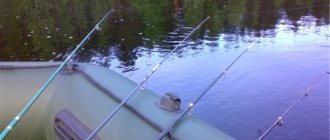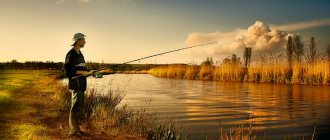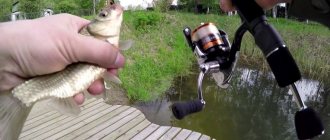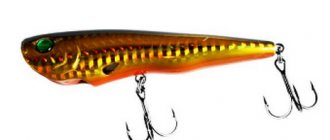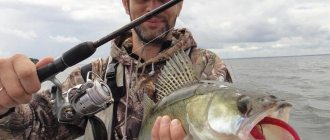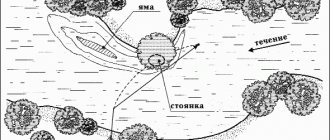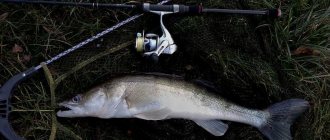Jig fishing is the name of spinning jig fishing, and one of its varieties is nanojig, in which a light jig head is used as bait. This method of fishing has received several names among the people - microjig, mormodoch, mormospinning, mormoshaker. But its essence does not change from the name, it is fishing with an ultra-light spinning rod, with ultra-light baits (nanojigs and jigs).
Fans of fishing are well aware that the successful outcome of a fishing session largely depends on the correct choice of bait. The jig is rightfully considered one of the most catchy and is used for fishing both in winter and summer.
Winter jigs have proven their advantages, especially since when fishing from ice, the choice of bait is limited and jigs are used with different types of equipment.
But spinning jig fishing in open water is also gaining great popularity, and this type of fishing has undoubted advantages.
Advantages of mormyshing:
- catchable bait regardless of weather conditions and the type of reservoir where fishing takes place;
- Both predatory and peaceful fish are caught, up to solid trophies weighing from 1 kg and above;
- The equipment is light and compact and does not take up much space;
- a wide selection of baits offered in stores;
- skilled fishermen make baits with their own hands, expanding the range and saving money;
- By choosing the right place and jig, you can catch a lot of fish in a short period of time.
Not every fisherman has time for a long session, but the desire to do what he loves is always there. Therefore, it is enough to have an equipped spinning rod and a set of jigs in the trunk of your car, and when driving past a river or lake, stop for an hour and a half to enjoy interesting fishing. At the same time, delicate and sensitive gear will give you many exciting moments when hooking and playing the caught fish, even if its weight does not exceed a kilogram.
When is the best time to fish with jigs?
Fishermen believe that the jig is the most catchy bait in winter ice fishing, but in such conditions they use not spinning rods for fishing, but winter fishing rods with a nod, which are more convenient when fishing from holes.
The advantages of jig fishing when catching a predator are best manifested in October - November, when the water cools down, but is not yet covered with a crust of ice. The fish moves around the reservoir in search of food, “fatten” for the winter.
The jig, which looks like an insect, shows its best side in such conditions. The main thing is to choose the right shape and color of the bait and perch or pike perch will definitely be tempted by its appetizing appearance.
When catching peaceful fish, spinning fishing with a jig is more effective in the spring months, when the ice melts and roaches or rams stay near the shore in places rich in food. Before the start of spawning, the fish “responds” to light baits and replenishes fat reserves after long cold weather.
Light jigs or jig heads do not cause any concern in such conditions and anglers are guaranteed an active bite. When fishing from a boat with a short spinning rod, or a longer one from the shore, anglers find fish and achieve excellent catches.
In the summer months, jig fishing is not so effective, because most of the fish go to the depths, and catching them with a spinning rod with light bait is not so convenient. In such conditions, fishermen use other types of gear, putting aside jigs until better times.
Bream on jig
I saw the first bream caught with a jig bait in October 2003. It happened on the Volga, near Mikhailovsky, on the famous Mikhailovsky Yar. The depth of the fairway drop was 15 m, the echo sounder highlighted the presence of peaceful fish, so it was quite logical to want to devote part of the short autumn day to breaking through this particular place. However, there were no bites from the predator for a long time. We were already thinking about changing the place, when suddenly someone took a “long” bite on my friend’s large yellow twister. The bites of jig fish are usually sharp and clear, but here someone simply pulled the line during a pause. It seemed like it wasn’t even a bite, but an accidental hook, the flushing of some slowly moving fish. Hooking, landing a solid trophy and now in the landing net... a bream worth more than two kilograms. It happens that when catching a predator from under a bream, the bream turns purple, but here everything was fair: the entire long tail of the twister was conscientiously swallowed by the bream, the double held the fish by the corner of its mouth. By the way, we didn’t find any pike that day, we caught a couple of medium-sized pike perch, so the bream turned out to be the most significant trophy.
The second episode with bream happened on a small Volga tributary - the Uzol River. In August 2004, my friend and I initially tried unsuccessfully to catch a chub. But the chub did not bite; the catch included several squints and perches. We decided to change the place - we moved to a deep (8 meters) Uzolsky quarry. And there, on the very first cast of the jig rig (two-inch light green twister, 4 g head) there was a rather vigorous bite. Fishing with a light spinning rod gave me a lot of pleasure, and after a couple of minutes we were able to see a kilogram bream raised to the surface. And, it seemed, the deed was already done, the bream gasped for air, as they say, “boomed,” but as soon as the comrade noisily jumped to the water’s edge with outstretched hands, the bream jerked and tore off the thinnest braid, carrying away a fashionable “earring” in its lip. Further casts with one- and two-inch twisters yielded only small perches; the bream no longer bit. The chance was lost.
Compared to the first and second episodes, the third case is indicative in that the catch of bream was not accidental, but was the result of purposefully catching this fish with a jig. My Moscow friends and I were fishing for pike in October 2005. There were three of us in the boat: Lena, Maxim and me. In one of the deep Volga channels we found a bream with an echo sounder, anchored on the edge and... immediately started catching pike. With a total depth of 11 m, the pike took 4-8, it stood “above the bream”. But in the very depths there was a school of bream. Maxim and I had already caught three pike up to three kilograms each, and Lena, as if she felt it, continued to make cast after cast not along the edge, but to the depth. She was tracking the bream and saying: “What do I need a pike? I don't want pike. I want to catch a bream, I want to catch a bream.” And what do you think? After some time (20-25 minutes, no more), Lena finally caught a bream! And I caught it honestly, in my mouth. And the twister is not to say that it was small - a three-inch golden “action plastic”, but, come on, a 2.2 kg bream coveted such prey.
What kind of fish is caught with a spinning rod using a jig?
Each angler has his own ideas about trophy fishing, and much depends on the gear used. It is not surprising that carp fishermen catch fish weighing 15–20 kg or more, because the gear they use allows them to achieve such results.
Using a spinning rod with a jig, it is unlikely that you will be able to catch a 20-kilogram fish, but light tackle gives an unforgettable experience when landing small fish.
Perch or roach weighing 200–300 grams caught with a jig tackle gives a serious fight to the fisherman, and it is not so easy to pull them ashore.
Naturally, heavier fish are found in the bycatch, but the main target is a predator or white fish weighing 100 grams or more.
The following can be caught using a jig with a spinning rod:
- bream;
- perches;
- ide;
- bleak;
- dace;
- ruff.
In general, for all the small fish that are in the reservoir, the main task is to find a promising place and choose the right bait. When fishing with a jig, spinners also come across zander and pike, and fishing for them turns into an exciting adventure.
Those who think that jig fishing is a simple type of fishing are seriously mistaken; only refined technique, the ability to “read” a body of water and correctly assembled gear help achieve solid catches.
Fishing gear
The main feature of jig fishing is the gear used. This applies to an ultra-light rod, and the smaller its test, the more interesting the fishing process. There are special requirements for a spinning rod for jig fishing, because you need a sensitive and lightweight blank that can cast light baits at the required distance.
An instant reaction to a bite and a clear hook are also impossible if you choose the wrong spinning rod. Experienced fishermen work the rod in such a way that the jig constantly moves in the water and reminds the fish of a living and appetizing insect, provoking a bite.
Jig fishing tackle consists of:
- light spinning;
- inertia-free spinning reel;
- fishing line or cord;
- jigs with a nozzle, or reelless jigs.
Requirements for jig fishing gear:
- ensuring the required casting distance for light bait;
- minimum weight, because the angler holds the rod in his hands all the time and “works” with the tip of the spinning rod;
- sensitivity when biting and sharpness in hooking;
- reliability when hooking and retrieving.
Spinning for microjig
Spinning for jig fishing should:
- ensure long-range and accurate casting of bait (jigs);
- fits comfortably in the hand;
- lead the bait so that it looks natural and reminds the fish of prey;
- instantly hook a pecked trophy;
- provide convenience when fishing;
- have strength and reliability.
The strength and reliability of a spinning rod with low weight and low test is a prerequisite for comfortable fishing. The modern fishing equipment market is rich in spinning rods with various characteristics.
But manufacturers do not have separate categories of rods specifically designed for jig fishing. Therefore, anglers select forms with the necessary parameters from those designed for spinning fishing from the shore or from a boat.
Fishing from a boat with a long spinning rod is inconvenient and for such fishing forms of shorter length are chosen. Accurate casting from the shore over a long distance requires a long and elastic blank and therefore blanks for shore fishing are longer.
Spinning rods for jig fishing are characterized and distinguished by:
- dough;
- formation;
- form material;
- length;
- grip width;
- weight;
- handle material.
The test of a jig rod does not exceed 5 grams, although there are anglers who use blanks with a test of up to 7–8 grams, especially those who prefer coastal fishing.
Spinning rods with a test weight higher than 10 grams are considered too rough for jig fishing, because retrieving a light bait with such a rod will not provide real drive. The smaller the spinning rod test, the higher its sensitivity and the easier it is to make wiring.
But reducing the test increases the cost of the form, and this factor is also taken into account by fishermen.
The rod's action is the main characteristic that affects casting distance, although length also matters.
The most effective fishing rods are:
- slow build;
- parabolics.
But in addition to providing convenience when casting long distances, such spinning rods also provide an attractive “game” of the jig in the water. With their help, it is easier to change the amplitude and frequency of vibration of the bait, and this increases the chance of attracting the attention of fish.
Spinning rods with a fast action are considered more sensitive, but they are difficult to work with a light jig, and this is a prerequisite for effective fishing.
Fans of jig fishing have to constantly hold the rod in their hands and cast the bait, so the weight of the blank plays a big role.
Spinning rods weighing up to 120 grams are considered the best for jig fishing and this is the extreme limit.
The optimal ratio of the weight of the blank, its sensitivity and strength are the main criteria for choosing a spinning rod for jig fishing.
Beginners are advised to buy spinning rods designed for catching lake and river trout; they fully meet the requirements for mormyshing forms.
Typically, such fishing rods are of high quality, but they are also quite expensive. On the other hand, nanojig uses one rod (this is not carp fishing or donkey fishing), so it’s better to immediately invest in a quality purchase than to have problems later on in the pond.
The best material for a spinning blank is graphite; it is light and durable, just what you need for fishing with small baits.
The length of the rod does not exceed 1.8 meters, this is enough for long casting and comfortable landing of fish.
If you have any doubts about choosing a fishing rod, pay attention to spinning rods designed for trout fishing; they are sensitive, super durable and hold fish well when playing.
The disadvantage of slow-action spinning rods is that they are difficult to cast accurately, so you need to take time to develop the necessary skills.
Jig reel
The casting distance of a jig depends not only on the length and stiffness of the rod, but also on the reel used.
The best choice is reels with low profile spools in sizes 1000-2000 from Shimano. When fishing with these reels, loops are eliminated and the line or braided cord is laid perfectly. To avoid problems with casting and retrieving while fishing, reels need regular maintenance, because during a session you have to make a large number of casts and the mechanism wears out.
Requirements that a jig fishing reel must meet:
- ensuring comfortable work with a thin base;
- minimum weight;
- reliability and durability.
Choose reels with a low gear ratio, because high speed when reeling in microjig bait is irrelevant.
The larger the reel spool, the easier it is to make long casts. But such a reel has more weight, and this is no less important for jig fishing.
fishing line
Beginners in mormo spinning buy expensive fishing line, believing that this way they make the tackle more reliable and durable.
This has its own logic, but when fishing with a spinning rod with light jigs, hooks and losses of baits occur, and sections of the fishing line have to be cut off. As a result, a skein of fishing line of 100–150 meters is enough for 3–5 fishing trips and the base has to be changed, which is an additional expense. Therefore, it is better to take a mid-price fishing line from the companies Salmo or Yamatoyo, which will cope with all the tasks. The diameter of the fishing line is from 0.1 to 0.14, but the thinner the base, the more sensitive the entire tackle.
On store shelves there are good and inexpensive fishing lines unrolled at 50 meters for winter fishing, and this option is really the most suitable for nanospinning. When choosing fishing line, it is better to give preference to monofilament with a special protective coating and minimal memory.
Braided fishing lines are also used in mormyshing, which, with a smaller diameter, are stronger than their monofilament counterparts. But after the braid gets wet and becomes heavier, the tackle becomes more difficult to throw over a long distance.
Fluorocarbon fishing line or fluorocarbon is also used when fishing with spinning jigs, only its breaking load is less than that of monofilament and especially cord. At the same time, fluorocarbon fishing lines are resistant to mechanical stress, and when fishing in difficult conditions this gives an advantage.
Fishing with a jig using a spinning rod: tips for beginners
This year, spinning fishing from the shore was allowed in our region. Now you don’t have to stop for a long month and a half, but continue doing your favorite fishing throughout the open water season. In past years, at this time we went to catch white fish with a float rod. As the water warms up, the common fish begins to migrate to spawn, actively feeding along the way. For my friends, this tradition has remained unchanged, but for me everything has changed. What's the point of sitting with a simple fishing rod if you can fish with a spinning rod? But since we are traveling in a group, which means spending time together, it would be wrong to go alone in search of a predator. The solution is simple: catch the same linen, but with a spinning rod.
We arrived at the place after noon. The guys took out fishing rods, and I took out “special-purpose tackle.” I’ve been fishing with a jig for several years now, so I knew what I needed to prepare. The kit looked like this: Norstream Areator AR582XUL rod (up to 2.5 grams), Shimano Stradic Ci4+ 2500 reel, cord No. 0.3. I tied an insert made of monofilament with a diameter of 0.1 millimeter to the cord so that jigs weighing 0.3–0.5 grams would fly further, and the stretch would absorb the brisk jerks of the white fish.
The fish immediately responded to the floaters, and I had to deal with its preferences. After some time, I selected the weight, volume and color of the jig. Bleak and rudd were caught from the surface, and closer to the bottom the sorog was biting. The fishing turned out to be very exciting and interesting. There were bites on every cast. The areator bent in an arc even on the smallest fish, conveying all the nuances of fishing. I won’t deny that fishing with a float rod was more effective, but fishing with a spinning rod was much more interesting. For those who will be fishing for whitefish with a jig for the first time, I want to give some useful tips that will help you navigate this specific type of fishing.
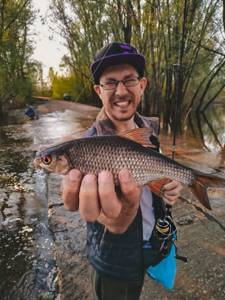
I'll start in order. I have already written about the tackle above, but I will repeat: the rod should be as light as possible, with a “regular” action. I settled on Areator up to 2.5 grams. The reel is light, with good line lay and a finely adjustable friction brake. You should fish with the brake completely loosened, tightening it as necessary during fishing: this will reduce the number of derailments.
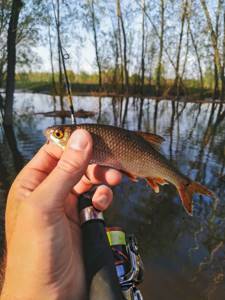
Be sure to use either thin braided cords (No. 0.2–0.3) or monofilament with a diameter of 0.8–0.12 mm. When using a thicker cord or fishing line, the cast will be very short and the sensitivity will be greatly reduced, which will make it impossible to use a jig.
It is best to use jigs weighing 0.3–0.5 grams. According to my observations, color does not matter much, but the size and thickness of the hook are very important. The thinner the wire, the better. And the size of the hook should be commensurate with the mouth of the fish being caught. If the hook is too large, the hooking will be minimal. Regular winter jigs such as ball, oatmeal, and droplet are ideal.
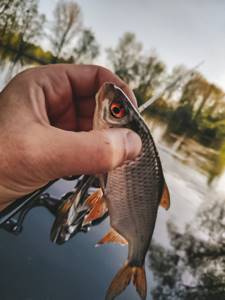
I use two types of bait: artificial and (less often) natural. Most often I use artificial bloodworms and maggots, less often slices of “edible” rubber in white and red. From natural ones I use maggot.
Let's move on to the most important thing - wiring and playing. I use only two wiring: uniform with pauses and wiring with “trippling” (monotonous swaying with different frequencies and amplitudes). It is necessary to fish the entire thickness of water from the bottom to the surface.
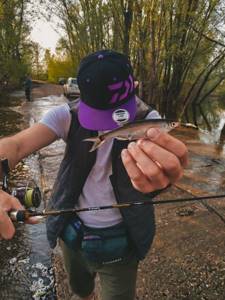
In my experience, it is not the game that is much more important, but the linear speed of the retrieve and the speed at which the bait falls. The longer you manage to keep the bait at the same depth with the slowest linear speed possible, the higher the likelihood of a bite. This combination can be achieved by adjusting two variables: the weight of the jig and the volume of the bait. In terms of weight, everything is extremely simple: the lower the weight, the slower the jig sinks. But in case of excessive lightening, the casting range is reduced. In this case, you can cheat by using lead jigs rather than tungsten ones. Also, the speed at which the bait falls is affected by its volume. It can be increased by using a more voluminous bait or adding maggots to the artificial bait, which will also affect the windage of the jig.

Since any fish can be caught on a jig, you can fish almost anywhere.
This knowledge will be enough to start fishing with a spinning rod.
For keen spinners like me, this will be much more interesting than sitting on the shore with a fishing rod. Share
Lures
Lures play a special role in jig fishing, because they are the ones that come into contact with the fish and should be:
- visually attractive;
- smelling delicious.
Jigs for search nanojig should be no heavier than 1 gram, otherwise the whole point of fishing in this style is lost. The hooks on jigs must be sharp and small in order to reliably catch the smallest trophy.
Materials for loading jigs:
- tungsten;
- lead;
- tin.
Tungsten has a higher density and with the smallest sizes of jigs, their weight allows for long casts. The best shape of the bait is selected experimentally, because the preferences of the fish change over several hours and a spherical jig will work better in the morning, and an oval jig in the afternoon.
For catching predators, bright, shiny jigs are preferable, teasing in the rays of the sun penetrating the water column. But for catching white fish, they choose lures of dark colors, and they work better on roach or blue.
A lead jig is used in cases where it is important that the bait sinks smoothly to the bottom of the reservoir. This kind of bait is easy to make at home and many fishermen prefer homemade ones.
Each jig fan usually has 2-3 dozen jigs of different shapes and colors in his box. Considering that the cost of high-quality bait is not so small, homemade products help you save money.
For ease of tying homemade lead jigs, they are made with an eye.
The best jigs for jig fishing are shot jigs (with a long fore-end, reminiscent of a jig head) and “Uralka” (with a short fore-end, decorated with multi-colored beads and cambrics).
Ultralight Club
Micro spinner. When catching white fish, I prefer, as with a regular spinning rod, braided line and, of course, thin line. FireLine Crystal 0.04 - 0.06 mm, Stren Microfuse 0.06 mm are quite suitable, although the most ideal option would be, for example, SunLine of the Small Game or Rock Fish series.
The rig must be equipped with a leash made of thin, no more than 0.12 mm, fluorocarbon, about a meter long. White fish are very careful, and such a leash helps to significantly increase the number of bites. If you tie the cord directly to the bait, then most likely there will be no bites at all. In principle, it is quite possible to get by with an ordinary fishing line used for float or match fishing, and it is advisable to use a fishing line of no more than 0.1 mm as the main one. It can simply be tied to a braid wound on a spool. 30 m will be enough, but I usually reel in with a small margin - 50 meters.
Lures
Now let's move on to the main thing - the baits. You can catch white fish (most often roach, rudd, bleak) using any type of bait - spoons, spinners, wobblers and silicone. But some of them require minor modifications.
Turntables. Nowadays there is a very good selection of handmade micro-turntables in stores, mainly “Maniacs” (in Kharkov we most often have them) and “Vyunovki”, which are more expensive and less accessible in our area. From a fairly wide range of these spinners, I prefer baits with relatively wide silver and black petals, which are especially loved by rudd and bleak. The smallest spinners from the Swedish company Mugap are very good, I especially like the 2-gram Mira.
From the large range of spinners from the legendary French company Mepps, in this case, the best suited for us are Streamepps, Aglia N00, Aglia Long No. 00 (I use petals of this shape quite rarely, but it is still advisable to have them in the box), in general, the smallest sizes bait But there is one caveat - they need to be improved a little. More precisely, the tee needs to be changed, since it is often too big for “white” fish. You need to carefully bite off the factory tee with pliers and insert a new small one through the winding ring. Although I personally prefer to use single hooks with a large eye - so that the hook does not “jam”. Of course, you can leave the original tee, but with it there will be more idle bites and an increase in the number of trips. Mepps has excellent models of spinners with a knitted front sight, but they are significantly more expensive than ordinary “flyless” ones and, again, the tee is too big (the exception is Streamepps, which has the correct size single).
To further attract the attention of the fish, some additional element in the spoon is highly desirable, so the question arises of additional decoration of the spoon. This can be a homemade edge, multi-colored beads, or silicone (PVC) cambric, put on a three-piece. The easiest way is to put on a colored piece of cambric, fortunately, now in stores there are quite a lot of different sets of cambrics for float fishing. It is advisable to have an assortment of spinners with cambrics of different colors, since the preferences of the fish may change during the day.
For starters, 3-4 spinners with petals of different colors and at the same time different cambrics, which can be changed during fishing, will be enough. Painting the spinners with an alcohol marker in a bright color often helps; for example, several red or black dots can significantly increase the number of bites.
In general, according to my observations, almost all improvements in the form of touch-up, front sight or a put-on cambric give the best result in the red-black color version, although, of course, this is not an axiom, and quite often it works, for example, fluorescent orange color, at least , from the options that I use. Micro-spinners have practically no competitors when fishing in the near-surface layer and especially justify their use in spring and summer. The edge can be knitted yourself from ordinary threads or from a set of feathers, which are rare, but still found on sale, for example, LineaEffe has an inexpensive set of feathers.
Wobblers. Micro-wobblers act as a competitive alternative to spinners. Small minnos from Tsuribito (Baby Minnow series), ZipBaits Rigge 35F and 35ss, a copy of the Jackall Chubby in a smaller version from River2See, Jackall Tiny Fry 38, a Vinnitsa stick walker (a smaller version of the Owner C'ultiva) and all sorts of the smallest cranks work well. .
When fishing with minnows, I use the most ordinary “perch” retrieve - these are either constant short wrist jerks, sometimes with small pauses. or sharper jerks with longer (up to 3 seconds) pauses. Larger minnows often work on white fish, although this is rather an exception.
I will give an example from my practice. A couple of years ago I was fishing with a spinning rod on a small river, catching mostly perch and pike. I set up the newly acquired CrackJack 48 mr sp from Ponntoon 21 with an eye on small pike, but it extremely surprised me with a dozen measured rudd weighing about 200 g. However, this wobbler continued to spoil me with bites of the same rudd and bleak, but, alas, not so often , as we would like. By the way, with cranks I most often use an ordinary, but very slow, uniform bait retrieve or a “stop and go” retrieve.
Oscillating spinners. Micro-spinners also performed well - here they are either Japanese trout ones or homemade ones. In general, Japanese lures are not particularly affordable in price, spinners are no exception, so “pieces of hardware” at the price of an average wobbler don’t appeal to me very much. There are quite a few homemade spoons of a suitable size for catching white fish; most of them are made for perch and pike, but options “for whitefish” are still available for sale, albeit in an extremely small assortment. For example, a 2-gram brass “Kastmaster” works quite well for me, which catches everything from perch to bleak. Of course, no one has canceled the option of making oscillating spinners yourself, and there is a vast field for experimentation.
Jig baits. The greatest variety in baits and independent delights in their manufacture is observed in micro-jigs. I use Owner and Gamakatsu jig heads from 0.5 to 3 or more grams, preferably without an influx of lead on the hook, which tears the already small silicone. I mostly use a “rigid hitch”, but sometimes I also use articulated heads. The hook must be thin and sharp, for example, the same Owner or Gamakatsu with a large eye. Although Overner hooks are preferable in this case, since their hook eye is turned out. Very often, instead of standard jig heads, I use tungsten jigs, which are noticeably heavier and smaller than lead jigs, and their shapes are more varied. I often use jigs such as “ball”, “banana”, “drop”. I prefer black and matte silver jigs, although sometimes I use fluorescent ones. When selecting suitable jigs, there is a nuance - the thickness of the hook, which should be as minimal as possible. And since we do not require the smallest jigs, there is some difficulty in finding suitable models and hook sizes.
Let's take a look at the silicone itself. I mainly use the smallest ordinary twisters, size 35 according to the Manns classification. The colors are a little more complicated, since the preferences of the fish often change. It is advisable to have at least such a small assortment: several options for “machine oil” (gold, red sparkles), “caramel with pepper”, “ultraviolet”, black with glitter, white, yellow, etc.
Edible perch rubber also works on white fish, but since it is mostly large, it needs to be cut: sometimes even just strips from relatively large twisters and all sorts of “freaks” work. In this case, the use of silicone bloodworms or maggots is justified. For example, the Berkley bloodworm works very well, especially when mounted on a jig.
It also makes sense to impregnate ordinary silicone with attractants for white fish; the French company Sensas has a good and not very expensive bloodworm option. Surprisingly, perch attractants also work against whiteness, for example a spray from the same Sensas or Cormoran gel. True, in such a situation the number of perch in the catch increases significantly, which in our case is still unnecessary.
Equipment
When catching white fish with a spinning rod, as with any other fishing, there are some small nuances in the angler’s equipment. In this case, fishing can be done both from a boat and from the shore. Therefore, it is highly desirable to have a fishing vest with pockets for boxes with baits and all sorts of small things, and it is advisable to have a fly fishing “sticker” for clinging spinners or silicone. You can make a “sticker” yourself, there is nothing difficult about it. It is needed in order to be able to quickly change baits, saving the time that the angler spends getting a box of baits and, in fact, replacing them. And so two or three main baits are attached to a vest and are ready for a quick change, which is sometimes so necessary in order not to let a school of fish go far from you. To some extent, the vest can be replaced by a special belt bag, which will fit all the “stuff” necessary for fishing.
To remove a hook from the mouth of a fish, instead of the forceps familiar to spinning anglers, which is more suitable for removing hooks from the mouth of medium-sized and large-sized fish, an extractor for float fishing is better suited, which is very convenient for removing hooks from medium-sized fish. By the way, it is very convenient for catching perch.
When fishing from the shore, especially in the spring, when there is quite a lot of water and the ban on fishing from a boat has not yet ended, the spinner will need “special clothing” to enter the water. Perhaps the most comfortable are wading boots, in which you can calmly walk along the shore and, if necessary, go into the water. Quite often, an angler needs to go deeper into the water than the wading allows; in such a situation, waders will be needed. I prefer PVC “sliders”, although neo-rene ones are better for cold water, they will be noticeably warmer, and they are also lighter. However, in warm weather, neoprene pants will not only be warm, but very hot, so think about comfort and convenience in advance.
By the way, if you take fish home, you should take care of a fish bag. Agree, it will be inconvenient to carry a fish tank with you, which not only gets in the way, but also scares the fish. In such a situation, a special shoulder bag for fish, for example from Rapala, will do a good job. Apparently, it is designed for trout fishing in a wade. In addition to compartments for bait, it has a special rubberized compartment for fish, which can be easily detached and washed if necessary. It is also convenient to use when catching perch from the shore. The bag fits about 3-4 kg of fish. I don’t know about anyone, but that’s enough for me, and the “extra” fish are simply sent to their native lands. As a matter of fact, such a rubberized tab can be glued together from old shoe covers or an OZK raincoat - there is nothing complicated about it. But when fishing from a boat, a medium-length cage is quite suitable.
Fishing tactics
Essentially, I would break down spinning fishing for whitefish into active and passive. Let's start with the active one.
It’s clear - before you catch a fish, you need to find it. First of all, circles on the surface, splashes - in general, any appearance of life under water - will help us. If the water is calm and, as they say, “dead”, you will have to look for fish sites on a whim - algae, reeds, snags or holes.
After we have found a promising place, we begin to fish it. There are already options here. First: we make fan casts about a third of what is possible, gradually increasing the casting distance by a third. Of course, you can cast exactly to the center of a promising point, but then after the first fish catches you will scare away the whole school, which is not good. When probing promising places, it is advisable not to go far into the water, so as not to scare the fish away with unnecessary noise and not to be exposed again.
The search for fish can be carried out either quickly enough or more thoroughly. If it's fast, then five or six casts will be enough. If the point seems more than promising to you, and you want to dwell on it “in more detail,” then about 10-15 casts will be enough. You can search for fish by moving from point to point, or you can gradually move along the shore and “shoot” the water area every 10-15 meters.
It’s clear that the most interesting thing will begin when you find a school. You can simply constantly move behind the school, you can try to “pull” the largest fish out of the school, or you can fish almost standing still. The most interesting thing is to catch a large roach, but, alas, it is not as interesting as it is difficult. The easiest option is to gradually increase the size of the bait.
Since it is not so easy to find a school of roach or rudd, it is best to keep it in one place after finding the fish and gradually “peck” the school. To do this, we will have to try to determine the approximate center of the school and fish it along the edges. This is important, because if we start fishing from the center, then after a couple of fish the school may get scared and leave, and we, you know, don’t need this at all. When fishing for a flock, it is highly advisable to change baits. For example, if he bites on a matte silver “maniac” with an Aglia type petal, then after 5-7 casts we put a similar one, but, say, black. Again, you can vary the types of baits - after changing three or four turntables, put a micro-jig on a jig. Such techniques fuel the fish’s interest in the bait and prevent it from leaving.
You can look for fish, or you can make it so that “the mountain itself goes to Mohammed”: simply attract fish with bait. This is a kind of semi-float path, but it is also very interesting and exciting. It’s all very simple - we select a suitable place, feed it, wait for the fish to come and, in fact, we catch! It is clear that during the fishing process you will need to throw in small balls of bait, which, by the way, will do almost anything with the inscription “Roach”, “Universal” or “Feeder”.
In the article, I deliberately kept silent about fishing for crucian carp, carp and bream with a spinning rod. For crucian carp and carp you need to go to paid reservoirs, and I rarely go to them yet, and although I caught bream, or rather bream, with a spinning rod, it was quite small and, in fact, as bycatch, accordingly, statistics for a separate publication not enough yet. Although, I hope that this is temporary and I will quickly learn what it is to catch the same carp, but the fishing is completely non-standard and unusual for carp anglers. And I really want to hold a beautiful bronze bream on the hook of an ultralight tackle!
Be sure to try catching white fish with a spinning rod and believe me - it is extremely interesting and exciting! In addition, such an unusual method of fishing may well add invaluable experience, which you can use to catch ordinary predatory fish.
Nozzles
To increase the attractiveness of the bait, the following attachments are put on the hook of the jig:
- worms, both whole and pieces;
- maggots;
- bloodworms, single or in bunches;
- artificial rubber tips.
Typically, anglers use additional baits when the bite on reelless baits dies down. The food preferences of fish in each body of water are most often constant, and if you managed to catch a good fish with a jig with a piece of worm, with a high degree of probability such bait will work on your next fishing trip. But you need to vary the bait if, after several trips, it was not possible to attract and catch fish.
It is not easy to keep animal baits fresh while fishing, so fishermen use artificial maggots, bloodworms or worms, which also increase the attractiveness of the bait.
It is considered the best manufacturer of artificial baits in the middle price category and, when going to reservoirs, its “edible rubber” is successfully used by many fishermen.
For white fish, an artificial bloodworm works well, and a single one, attached to the hook of a jig with a stocking, or by the head. Roach and crucian carp, bream and even bream are well caught with such bait and every fisherman should have it in his tackle box.
But small white fish, such as bleak or bluegill, prefer artificial maggots from “Lucky John”, although perch and even pike perch also bite on them. Choosing a white or colored maggot as a bait is the decision of the fisherman himself, especially since, as we remember, the preferences of the fish change literally in a few hours.
Edible rubber is good because it is securely held on a small hook and is very similar to real animal food. Treatment with special aromatic liquids increases the attractiveness of the bait, and the fish takes it willingly, without fear of a catch.
The advantages of artificial baits are that they are reusable; they do not require special care; just dry the rubber maggot or worm and put it in a box until your next fishing trip. Even a bait damaged by the fish’s teeth can work in the next session, so don’t rush to give up using it.
Artificial rubber nozzles are sold in small jars or boxes and they:
- lungs;
- compact;
- convenient to transport.
In one package they offer baits of different colors, which expands the angler’s possibilities on the pond, because in the morning and in the evening the fish react to the color of the bait differently.
They also activate the fish’s bite with the help of pheromones that affect its receptors.
It is worth paying attention to products that have long been considered the market leader. The disadvantage of this company’s artificial baits is their high cost, especially compared to competitors, but their quality fully compensates for the costs.
One jar of artificial bloodworms or maggots from the Berkeley company is enough to fish for 2-3 seasons, and fishing performance increases significantly. Adding flavors to jars with Berkly baits increases the appeal and the fish really like them.
In the last 3-4 years, Russian manufacturers of fishing products have also introduced their artificial baits. Their quality is lower than that of the Americans, but the cost is 2-3 times less.
Homemade artificial baits are also popular with fish, and there are reservoirs where small pieces of foam rubber or edible rubber work no worse than industrial models.
It has been noticed that edible rubber attracts trophies not only when retrieving the jig, but also during pauses in the “game.” It turns out that the main luring factor for the fish is the artificial bait, and the jig is used to deliver it to the point and properly “play” in the water column.
It often happens that changing the amplitude or pace of fishing with the same nozzle still makes the fish interested in the bait.
When fishing with reelless baits, they are decorated with multi-colored cambrics, pieces of rubber or thread. In addition to the fact that this adds variety, the jig itself, when inserted, creates sound vibrations that are picked up by the fish.
Shiny jigs with a combination of white and red maggots, or bloodworms, performed well for predatory fish.
Plant attachments
Bread crumb
Most often, the crumb of black bread (preferably rye) is used, flavored with milk, raw egg yolk, honey, and unrefined vegetable oils. White bread has less natural odor, but is also good; more often fragrant oils are added to it, sometimes it is even painted red. True, you should not overdo it with odorous substances - the effect may be the opposite of what was expected. Therefore, stick to approximately the following ratios: to prepare 1 kg of dough or bread crumb, 1 tablespoon of unrefined vegetable oil is enough, and no more than 5 drops of anise oil. But not every fish reacts equally to such bait, therefore, when going fishing, it is advisable to have both natural and flavored baits. Bread crumb can be mixed (to obtain a homogeneous viscous mass) with potatoes, homemade cheese, etc.: per 10 g - 0.6-0.8 g of such additives. Balls of various sizes are molded from the doughy bread mass, depending on what kind of fish the angler is counting on. Bream, roach, etc. are usually caught with this bait.
Dough
Typically, stiff dough is kneaded from plain-ground rye and wheat flour. Sometimes raw egg yolk and honey are added to it. It’s good if you boil the pellets with boiling water. This gives the bait an attractive appearance and increases its stability on the hook. You can tint the dough with food coloring, this also gives a positive result. Very often, fishermen prepare dough from semolina; pellets of such dough are firmly held on a hook, the tip of which must be hidden. Fish are sensitive to odors, and smokers should take into account the fact that the smell of nicotine from the fingers is transferred to the nozzle and scares away the fish. All carp fish are well caught using the dough.
Cereal grains
These are rye, barley, oats, wheat, corn, and less often pearl barley. On the day of baiting, high-quality and unpeeled grains are taken. It's good if you boil them in milk. The cereal grain is pierced with a hook from the back, leaving its tip open (it should come out or at least be palpable). Corn of milky-waxy ripeness does not need to be soaked, much less boiled: it will serve as a bait for carp and carp - just what you need. And with other baits made from cereal grains, bream, silver bream, podust, white bream, etc. are caught well.
Peas
Peas (white, green, gray) are considered one of the best baits for catching bream, carp, roach, etc. It is advisable to bait the fish in the fishing areas you have chosen. The bait should be prepared only from whole grains, with the skin intact. First, the peas are soaked in water with the addition of salt per 1 liter - 1 teaspoon. The swollen peas are placed in a bag, which is suspended in the pan so that it does not touch the bottom. The peas are boiled in the same water in which they were soaked. It is advisable to add 2 cups of milk and an additional 1/2 teaspoon of soda for every liter of water. You can steam peas in milk alone. Do this over moderate heat (until fully cooked). The peas are then cooled. Ready peas are sometimes wrapped in a clean cloth, lightly moistened with linseed or hemp oil. Usually 1 large pea (or 2-3 small ones) is put on the hook. At the same time, it is recommended to squeeze it slightly so that the flesh appears at the puncture site. Canned peas are also used as a nozzle.
Porridge
This attachment is prepared mainly from millet cereals. High-quality grains are selected, sifted and washed well. For 1 glass of grain 2 - water. Keep on low heat until the grains are completely boiled. After this, they are ground until a homogeneous dough is formed. Then the loosely closed pan is placed in the oven, where the porridge rests for 2-3 hours. Throughout this time, it is periodically stirred to prevent burning. It is better if it is cooked with milk. You can add a little flaxseed or hemp oil to the finished porridge. Roll the cooled porridge into small balls. They use this bait to catch roach, chub, crucian carp, ide, etc.
New potatoes
For bait, pieces of young undercooked tubers are used, as well as mashed potatoes mixed with wholemeal rye flour or bran. To catch large fish, small tubers the size of a hazelnut are selected and placed whole on the hook. Boil the potatoes in slightly salted water; you should not peel them before doing this - the skin of the finished tubers can be easily removed. And, as experience shows, fishing with whole and partially peeled tubers gives the best results. Young boiled potatoes are one of the best baits for large roaches, chubs, ide, etc.
Cheese
Take white, soft, viscous and unsalted cheese onto the nozzle, cut it into square pieces, slightly smoothing the corners. The result is a nozzle in the form of a pea or nut. Cheese crumbs are used to feed the fish. The disadvantage of this bait is that in fast currents it is washed off the hook.
Cake
Cake - hemp or flax pomace. You can also use sunflower seed pomace. The fish readily takes the bait from them, but it does not hold well on the hook. Therefore, it is better to add them to dough or bread crumb, soak them with crushed cotton wool, fry them in a frying pan and cut them into small cubes. This bait is used for carp, crucian carp and roach.
Silkman
Mulberry (green) is a filamentous algae of bright green color, reminiscent of strands of the finest silk. Grows in weak currents on stones, snags, sunken trees, piles. This is food that roaches, ide, and chub feast on. Young, short plants with bright colors are chosen for bait. The torn strands are washed, then tied into small bundles and lowered on a strong thread near the shore into water with a weak current. Fresh algae is placed on a hook as follows: take a strand of thread 6-8 cm long, the thickness of a match, twist a flagellum from it, which is put on the hook in a figure-of-eight loop and slightly tightened. The excess end is cut off. The length of the hanging strand should be no more than 2 cm. The hook tip remains open. You need to look for fishing spots with this bait where mulberry grows.
Bait for fishing with light jigs
The use of bait in the form of loose mixtures when fishing with jigs is the exception rather than the rule. Using a light spinning rod, the fisherman fishes large areas, moving along the coastline in search of trophies. And fans of light spinning rods have practically no ways to cast bait long distance.
But the tactic of targeted feeding at close range also works, when small fish gather on the loose mixture, and predators follow it, sensing nearby prey. It is impossible to carry a large amount of bait in a backpack or waist bag, so it is not used very often in jig fishing.
Fishing and retrieving techniques in jig fishing
The advantage of jig fishing over other types of fishing is the wide variety of fishing lines used in fishing. In addition to standard types of fishing, fishermen invent their own combinations that bring fish even when they cannot be caught in other ways.
The main task is to achieve such an animation of the bait (using the tip of a spinning rod) that will attract the attention of the desired trophy. You need to determine in what place and at what height the fish is standing, and by changing the types of fishing, this can be done easily.
Experienced fishermen believe that the choice of fishing line is an individual decision for each body of water, but it also depends on:
- type of reservoir;
- types of supposed trophies;
- depth at the fishing point;
- fish activity;
- season when fishing takes place.
After all, it’s one thing to catch a roach in a pond and quite another thing if you catch a perch or the same trout in a stormy river. The growing popularity of jig fishing is precisely due to the fact that it is used in those reservoirs where there seem to be few fish, but with the help of a spinning rod and a light bait it is possible to catch them.
Fishermen do not always have time to go to a rich body of water far from home, so jig fishing in the reservoirs of the park area becomes an outlet. It’s not even a matter of the size and number of trophies, but the opportunity to do what you love again and again and get great pleasure from it.
Wiring during nanojig is conventionally divided into three types:
- pulling bait in the bottom layer;
- wiring in the water column at an average level;
- animation of the bait near the surface.
The fish standing in the bottom layer are larger, but a light bait should sink faster, and the angler will feel how close to the bottom it moves. Crucian carp can also be caught with jig fishing, although not as large as with a float or feeder.
What it’s like to bite even a 300-gram crucian carp on an ultra-light spinning rod is known only to real fans of jig fishing, who know how to perform effective retrieves near the bottom.
Bottom wiring is fraught with snags and loss of jigs, but this has to be treated as an inevitable fact. Jigs are still consumables and losing them while fishing is a common occurrence. That is why experienced fans of microjig always carry a large supply of jigs of different weights and colors with them to reservoirs.
When fishing from a boat, there is always a place for a box with bait, but when fishing in a wade, you need to use unloading vests or belts with pockets for storing jigs, baits and tools. A short landing net, attached to the hand with a cord, will also not hurt, making the process of landing fish easier.
In the middle layers of the water there are different fish, both white and predator, and it is difficult to predict which of them will bite first.
Selection is carried out using:
- choosing the shape and color of the jigs used;
- the wiring used;
- a bait placed on a hook, artificial or live.
Pulling the jig in the middle layers of water is done at a slow pace, animating the bait with the tip of the rod. The wiring is smooth with low amplitude and without sudden movements that scare away the fish.
With its energetic movements, the jig attracts perch or pike perch, rising from the bottom in search of a school of small fish. But the fisherman needs to be careful and immediately react to the bite, because a late hook will lead to the trophy disappearing.
The perch takes the bait greedily and at the same time seems to lose caution. In fact, the predator is very attentive and any careless movement of the bait will alert it and force it to refuse to bite.
Placing bait in the upper layer of water is somewhat reminiscent of fly fishing. The movement of the bait is smooth and measured, without sudden movements or impacts. This technique requires attention and experience, because the jig strives to sink to depth and in order to keep it on the surface you need to clearly act with the tip of the spinning rod.
At the top, peaceful fish bite better and to attract them they use semi-dry bait floating on the surface of the water.
Expert opinion
Vladimir Poltoranin
Fisherman - expert
The technique of moving a jig with a spinning rod also changes depending on the season:
In winter , after the onset of cold weather and freezing of reservoirs, spinning rods are not used, but are fished with jigs using winter fishing rods equipped with nods. In the spring, when the open water season begins, spinning rods are uncovered and jig fishing proves its advantages. At such times, fish stay in coastal areas, where the water is warmer and the food supply is more abundant. In spring, it is more promising to conduct in the upper and middle layers, at an average and slow pace, with virtually no sudden jerks. The bites are sluggish and at the slightest vibration of the whip a sharp hook is made. Jigs use shiny or bright colors with animal baits - bloodworms and maggots. the summer , there is freedom for the fish in warm water and there is plenty of food for them in the reservoir. In such conditions, it is more difficult to get both predators and peaceful fish to bite on the jig, so it is especially important to vary the technique of posting and experiment, showing aggressiveness. Fishing at long distances is more effective, as is fishing in the lower layers of water, where trophies are kept. In the morning hours, they fish from a boat areas near the reeds at shallow depths. As the sun rises, anglers go to greater depths, using energetic movements with the tip of the spinning rod when fishing. Highly attractive artificial baits and jigs in calm shades help diversify your fishing and achieve results. The weight of the jigs is selected so that they can be thrown long distance. Fishing at dawn and sunset is more successful and brings a plentiful catch. In autumn , during this period of the year, it is especially important to carefully study the reservoir and search for future wintering pits. Despite the fact that the fish is still moving in search of protein food, it involuntarily stays closer to its future wintering areas. In summer and autumn, fishing from a boat with short spinning rods is more effective. Light jigs, artificial baits in white and yellow. Autumn jig fishing is especially rich in trophy fish, and when fishing, you should not make sudden movements with a spinning rod so that the fish does not come off and the tackle can withstand a heavy trophy.
Types of postings
There are several types of postings in mormyshing that have shown good results, here are some of them:
- Bottom wiring , used in summer and autumn. After casting over a long distance, the slack in the fishing line is removed. The jig with the nozzle reaches the bottom. The tip of the spinning rod is raised at an angle of 60–70 degrees, and “trembling” movements are made with an amplitude of up to 3–4 cm. When lifting the rod, the reel remains motionless. The next stage is when the tip is lowered to an angle of 30º, and the slack in the fishing line is removed by winding the reel. This is followed by raising the tip to 60º and the process begins all over again. When lifting the top, 1-2 second pauses are made and the movement continues. The described wiring guarantees constant contact between the spinning rod and the bait and allows you to “tap” the bottom, which perch really likes.
- A simple wiring option for beginners - after casting a jig with a nozzle, make 6-7 swings, and then a 2-3 second pause. The retrieve is slow for fishing in the upper and middle layers. Pauses and changes in the frequency of drawing, shaking the end of the spinning rod are only welcome, as the wiring is more varied and the jig vibrates differently.
When catching white fish, do not use the technique of quickly oscillating the jig, especially if it is not active. Here you need a smooth and slow retrieve, in which the fish notices the bait and decides to bite. With a predator, everything is different and the sharp vibrations of the jig are attractive and interesting for him.
Most often, the angler does not know what kind of fish is at the fishing point, so in the absence of bites, the pace of the retrieve varies from slow to fast. This technique will make it possible to interest both the predatory perch and the “peaceful” roach, and ultimately, the angler wins.
The best maneuvers in jig fishing, both for beginners and experienced fishermen, are considered to be:
- uniform wiring in the water column with short twitches (for such wiring, the Uralka jig is best suited);
- wiring with rare twitching and pauses (often long).
When fishing in the current, the bait is thrown 5–7 meters above the fishing point. It is important to ensure that during the “game” the jig moves near the bottom and does not rise high.
White non-predatory fish for spinners, wobblers, jigs...
Non-predatory white fish, under certain circumstances, exhibit a predatory instinct and expand their diet at the expense of fry. At this time, you can catch it with a spinning rod, a lure, a wobbler and other baits that everyone uses to catch pike and perch.
But if instead of pike perch and pike you come across a heavy bream or carp, usually spinning anglers are not against this turn of events, they take advantage of the situation and purposefully catch non-predatory fish with a spinning rod. What circumstances force white fish to take spinning baits, and how to succeed in such fishing... It is especially interesting that the largest individuals of the carp family most actively hunt for fry.
Under what conditions is white fish caught using a spinning rod?
It is known that occasionally spinners come across representatives of the non-predatory world using spinners, wobblers and silicone, most often rudd, bream, crucian carp, and silver bream. But there are also roach, carp, bleak...
Under certain conditions, the bite of white fish on spinning baits ceases to be an accident and becomes constant and confident.
- After floods caused by rain or melting, a lot of demolished, weakened, broken small things accumulate in quiet places on the rivers. It's not just predators who flock to this feast. Here, large white fish are regularly caught with a spinning rod for several days or weeks.
- In winter stopover areas, in dense schools of fish, competition for food becomes very high. This leads to the fact that all large non-predators begin to feed on the fry as well. Let's take a closer look at how this happens.
White fish become a predator in wintering pits
In the second half of autumn, in rivers and lakes, dense schools of white fish cling to the deepest pools, which are usually known to anglers and are called wintering holes. In flocks there is high competition for food. Nearby there are large schools of fry that have moved away from the shallow shores. The presence of such food, which is easy to obtain, cannot but provoke white fish.
The situation is also fueled by slow digestion in cold water, when hard-to-digest plant food is not welcomed by large fish, but animal food, including small fish, is considered tolerable. It has been noticed that even pike, which mainly feeds on larger fish, in the pre-winter time switches to small fish, and begins to be caught exclusively with small baits, and the caught specimens sometimes have fry strung on their teeth.

When and where do you catch white fish on a spinning rod?
Whatever the theory, the facts are that the autumn-winter period is the time when white fish are guaranteed to be caught using spinning rods in their wintering areas. This happens all the time in most bodies of water, including even lakes and stakes, where the fish are usually not so aggressive. Nevertheless, even there, “cold and hunger” and the presence of food nearby, for which there is no need to travel, at a time when the fish has minimal energy and movements are slow, force carp fish to be predators. The largest carp are also caught using spinning baits, but we will talk about this later... Summer incidents, when a lot of easily accessible fry appear, are rather random in nature. Nevertheless, experienced spinners can take advantage of such circumstances.
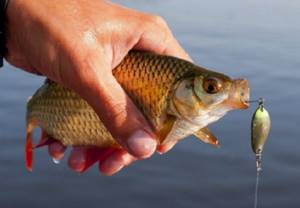
What to catch
Whitefish sites are usually not close to the shore, so a long cast is required. At the same time, very light baits are used - spinners No. 0, No. 00, microwobblers, microjigs, streamers, wabiki, or just a hook with some kind of thread... To throw all this you need additional weight. But the rod is usually used light or even ultra light if you are fishing not far away. The rod should be of a soft action, whip-like, which is called “poly” - for powerful casting of light equipment. The fishing line is the thinnest, and soft monofilament or braided material of appropriate quality - with a minimum of windage. For example, for zeroing a spinner, a soft monofilament with a diameter of only 0.12 - 0.13 mm is recommended... A coarse and cheap reel cannot be used to work with this fishing line.

Features of baits
Nulevka spinners often work better in the middle layers of water, and rudd and roach are caught well. The smallest versions with a propeller tempt bleak, roach, and dace.
For bottom-dwelling bream and silver bream, as well as ide, microjig baits and streamers are more tempting. In this case, the wiring is near the bottom - the smallest step.
What spinning bait for bream, silver bream and carp
Bright little twisters are a universal bait for spinning fishing for large bottom fish in cold water - bream, ide and carp. But their use is possible on a long lead leash.
Also catching white fish is small foam rubber, which, as you know, creates more noise in the water. A foam rubber fish for catching large white fish looks something like this:
- length no more than 70 mm (it’s better to start with the smaller one), with a diameter of up to 10 mm. The bait is used in conjunction with a small double...
Hook - a small double, possibly decorated with thread or beads, is an excellent bait, installed at some distance (50 - 100 cm) from the sinker, or the main bait. When a fish simply butts a bulky bait, then most likely the smaller option, in particular a bare hook, will take it confidently, which has been repeatedly tested in practice
There are also many more options available, which will be discussed below...
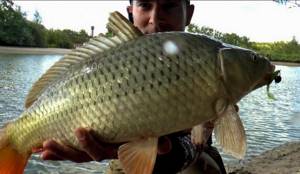
Wiring along the bottom
A special technique for catching large white fish is that the jumps are made especially short, the bait literally plows the bottom, raising turbidity. Slow retrieval with short jumps allows the sluggish fish to catch up with the irritating object. In this case, the jump is made literally in a quarter turn of the spinning reel handle.
The sinker does not come off the bottom in any noticeable way, but rather kicks up clouds of silt. If a light bait is installed on a retractable leash, then it will make more sweeping movements, more noticeable and noisy for the fish.
What other rigs and baits work?
- A drop-shot rig, where the bait is on the main line above the sinker, works well. Wiring features are selected.
- A tandem bait for white fish also works - up to 3 pieces are tied to a heavy jig on short 2 - 3 cm hard leashes. jigs, which are usually decorated with beads or living creatures (replanting). At the same time, after each step it is useful to take a noticeable pause or stretch very slowly.
- Jig spinners are a classic bait for autumn fishing for white fish. At the same time, the dimension of the round petal is 5 – 7 mm.
- Small silicone baits. Often they are made independently, cutting off excess silicone with scissors from summer options. They work great on all white fish, including carp, especially the noisy ribbed versions...
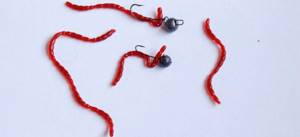
Fishing for carp with a spinning rod
Where there are a lot of carp, especially in well-flowing reservoirs and rivers, a spinning angler can count on success during autumn fishing. It is known that in the pre-winter period large carp take animal food well. Malek, pieces of fish, baits made from fishmeal are often the best baits for carp at this time.
A good bait for carp is the same small spinner jig. Loading – no more than 10 grams, otherwise the balance of the entire equipment will be disrupted. The bite occurs at the beginning of the step (when rising from the bottom) and is felt as a soft hold, which gradually turns into a powerful pull for a couple of tens of meters.
The place of bites is a drop to depth, the border of a hole, an edge from shallow water. Sometimes, carp go aground, but only on the one adjacent to the main deep-sea anchorage. If such an area exists, then it also needs to be fished. For such fishing, you need a spinning rod and a reel of appropriate power, a soft blank, and a slow action.
Wading fishing with zero spinners
At the border between the shallows and the cliff in the depths, it is not uncommon to observe white fish hunting for fry. From the outside it looks as if a rudd or something larger is attacking insects on the surface - small whirlpools, eddies, and breakers occur without a splash. But there are no insects in the cold air, but a small fry moved from the shallows to the depths, and schools of bream and carp rose to meet it...
When white fish hunt for fry during the day, small zero-rated spinners, drawn along the surface and into the floor of the water, work well. But the problem is that it is often impossible to get them to such feeding areas from the shore. Instead of using too heavy equipment, it is better to fish in a wade, reducing the distance with the schools as much as possible. At the same time, the thickness of the monofilament line is no more than 0.14 mm. But for this you need the appropriate equipment...

